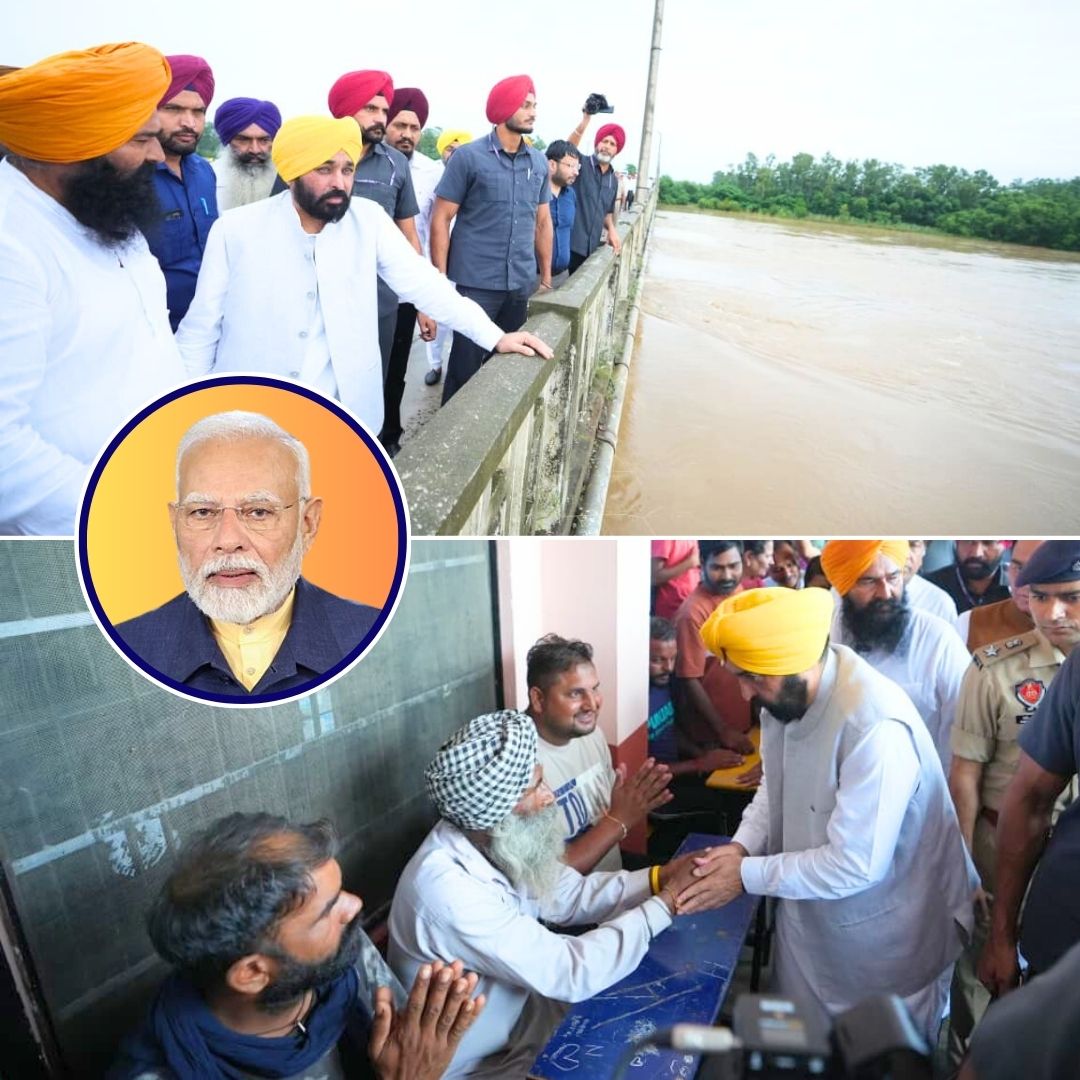Heavy rains on Monday intensified the flood crisis in Punjab, with 12 of 23 districts under red alert and over 2.56 lakh people affected. The Sutlej, Beas, and Ravi rivers surged dangerously, inundating large areas and damaging over 2.3 lakh acres of agricultural land, threatening the vital paddy crop season. The state recorded 29 deaths and three missing persons due to drowning and electrocution.
Prime Minister Narendra Modi, after returning from China, personally called Punjab Chief Minister Bhagwant Mann to discuss relief efforts and assured full central support as NDRF, Army, and local teams continue rescue operations.
Flood Impact Worsens Across Punjab
Punjab is grappling with some of its worst floods in decades as relentless rainfall and swollen rivers have flooded villages, towns, and farmlands across districts including Gurdaspur, Pathankot, Fazilka, Kapurthala, Tarn Taran, Ferozepur, Hoshiarpur, and Amritsar. Thousands have been evacuated from affected areas, and around 7,144 people are sheltered in 129 relief centres.
The flooding has caused severe damage to homes, infrastructure, and crops, with critical concerns over food security as the paddy season is at risk. Many cities are facing urban flooding and electricity outages, with shutdowns of industrial plants in some areas due to waterlogging and sewage backflows.
Historical Flood Context and Ongoing Challenges
Punjab is facing the worst floods since 1988, primarily due to heavy monsoon rains and increased water discharge from upstream hill states of Himachal Pradesh and Jammu & Kashmir. The three major rivers, Sutlej, Beas, and Ravi, are all at critical flood levels, with sustained rains predicted through September 3.
The floodwaters have submerged over 2.32 lakh acres of farmland, disrupted transport and daily life, and resulted in casualties overwhelmingly caused by water-related accidents and electrocutions. Educational institutions have been closed statewide till September 3 for safety. Efforts to map and assess losses to livestock, homes, and infrastructure are underway as waters slowly recede.
Massive Rescue and Relief Efforts by NDRF and Allied Forces
The National Disaster Response Force has deployed 20 teams to flood-hit regions, aided by 10 columns of the Army, Navy, Air Force, and Border Security Force along with their engineer units. Over 35 helicopters are involved in rescue missions, employing more than 110 boats and one state helicopter.
Thousands have been evacuated from submerged areas such as Gurdaspur, Ferozepur, and Fazilka. Evacuees are accommodated in 129 relief camps where dry rations, medical facilities, and fodder for livestock are provided. Relief officials have set up medical camps and reinforced embankments to prevent further flooding.
🌊#FWR Ops | Punjab | 01 Sep
— NDRF India I राष्ट्रीय आपदा मोचन बल 🇮🇳 (@NDRFHQ) September 1, 2025
🔸NDRF teams conducted #FWR Ops in flood affected areas of Punjab
🔸Evacuated 369 persons and shifted to safer places
🔸Assisted Civil Adm. in #Relief distribution
🔸Medical aids also provided to affected people#आपदा_सेवा_सदैव_सर्वत्र 🙏 pic.twitter.com/C2iJVYMK1u
The Logical Indian’s Perspective
The unprecedented floods in Punjab underscore the urgent need for long-term climate adaptation, improved flood management infrastructure, and disaster preparedness to protect vulnerable communities.
The Logical Indian calls for collaborative efforts between policymakers, scientists, and citizens to build ecological resilience and ensure social solidarity during emergencies. Compassionate dialogue and inclusive planning must be prioritised to safeguard lives and livelihoods amid climate volatility.
ਅੱਜ ਸਬ-ਡਵੀਜ਼ਨ ਟਾਂਡਾ ਵਿਖੇ ਹੜ੍ਹ ਪ੍ਰਭਾਵਿਤ ਇਲਾਕਿਆਂ ਦਾ ਦੌਰਾ ਕੀਤਾ। ਸਥਾਨਕ ਲੋਕਾਂ ਦੀਆਂ ਦੁੱਖ-ਤਕਲੀਫ਼ਾਂ ਨੂੰ ਸੁਣਿਆ ਅਤੇ ਹਰ ਕਿਸਮ ਦੇ ਨੁਕਸਾਨ ਦੀ ਭਰਪਾਈ ਦਾ ਭਰੋਸਾ ਦਿੱਤਾ।
— Bhagwant Mann (@BhagwantMann) September 1, 2025
ਸਾਡੇ ਲਈ ਸਭ ਤੋਂ ਜ਼ਰੂਰੀ ਪਾਣੀ ‘ਚ ਫਸੇ ਲੋਕਾਂ ਤੇ ਬੇਜ਼ੁਬਾਨਾਂ ਦੀ ਜਾਨ ਬਚਾਉਣਾ ਹੈ। ਸਰਕਾਰ ਵੱਲੋਂ ਲੋਕਾਂ ਦੀ ਹਰ ਸੰਭਵ ਮਦਦ ਕੀਤੀ ਜਾ ਰਹੀ ਹੈ। ਅਸੀਂ… pic.twitter.com/LwQJgiFLIW












